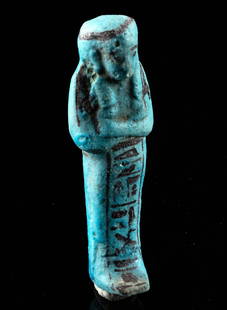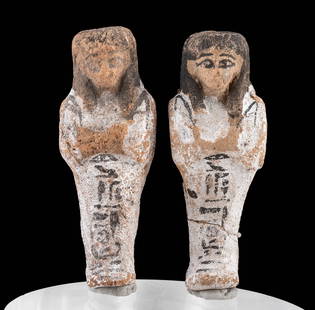

 Discovery- InteriorsBonhamsSponsored.Your ad here?
Discovery- InteriorsBonhamsSponsored.Your ad here?



Discovery- Interiors
Bonhams
Sponsored.Your ad here?


 Discovery- InteriorsBonhamsSponsored.Your ad here?
Discovery- InteriorsBonhamsSponsored.Your ad here?



Discovery- Interiors
Bonhams
Sponsored.Your ad here?

Egyptian Third Intermediate Period Faience Ushabti
Similar Sale History
Recommended Items






Item Details
Description
**Originally Listed At $600**
Ancient Egypt, Third Intermediate Period, 21st to 25th Dynasty, ca. 1070 to 664 BCE. A gorgeous mold-formed faience ushabti covered in cornflower-blue glaze and decorated with applied black paint. The figure stands in mummiform with fused legs and protruding feet, holds the symbolic pick and hoe in hands crossed atop the chest, and has a small seed bag suspended with two straps across the verso. The minimal visage boasts black-painted eyes and brows, smooth cheeks, and a small nose, all beneath a simple tripartite wig and a black-painted head band. A column of hieroglyphic symbols is painted onto the front of the legs and, while untranslated, would provide the name of Osiris as well as the name of the deceased. Size: 1.3" W x 3.25" H (3.3 cm x 8.3 cm); 4.6" H (11.7 cm) on included custom stand.
Shabti (or ushabti) dolls are figures shaped like adult male or female mummies wearing traditional ancient Egyptian headdresses. The ancient Egyptians believed that after they died, their spirits would have to work in the "Field of Reeds" owned by the god of the underworld, Osiris. This meant doing agricultural labor was required by all members of society, from workers to pharaohs. By the Third Intermediate period, this practice had become so necessary and elaborate that some tombs contained one worker for every day of the year and thirty-six overseers, each responsible for ten laborers. The wealthier nobility in Egyptian society were able to have shabtis made of coveted faience, and blue faience was meant to reflect the color of the river Nile both on earth and in the afterlife.
Provenance: ex-Hilja K. Herfurth collection, Denver, Colorado, USA before 2000 through family inheritance
All items legal to buy/sell under U.S. Statute covering cultural patrimony Code 2600, CHAPTER 14, and are guaranteed to be as described or your money back.
A Certificate of Authenticity will accompany all winning bids.
PLEASE NOTE: Due to recent increases of shipments being seized by Australian & German customs (even for items with pre-UNESCO provenance), we will no longer ship most antiquities and ancient Chinese art to Australia & Germany. For categories of items that are acceptable to ship to Australia or Germany, please contact us directly or work with your local customs brokerage firm.
Display stands not described as included/custom in the item description are for photography purposes only and will not be included with the item upon shipping.
#147243
Ancient Egypt, Third Intermediate Period, 21st to 25th Dynasty, ca. 1070 to 664 BCE. A gorgeous mold-formed faience ushabti covered in cornflower-blue glaze and decorated with applied black paint. The figure stands in mummiform with fused legs and protruding feet, holds the symbolic pick and hoe in hands crossed atop the chest, and has a small seed bag suspended with two straps across the verso. The minimal visage boasts black-painted eyes and brows, smooth cheeks, and a small nose, all beneath a simple tripartite wig and a black-painted head band. A column of hieroglyphic symbols is painted onto the front of the legs and, while untranslated, would provide the name of Osiris as well as the name of the deceased. Size: 1.3" W x 3.25" H (3.3 cm x 8.3 cm); 4.6" H (11.7 cm) on included custom stand.
Shabti (or ushabti) dolls are figures shaped like adult male or female mummies wearing traditional ancient Egyptian headdresses. The ancient Egyptians believed that after they died, their spirits would have to work in the "Field of Reeds" owned by the god of the underworld, Osiris. This meant doing agricultural labor was required by all members of society, from workers to pharaohs. By the Third Intermediate period, this practice had become so necessary and elaborate that some tombs contained one worker for every day of the year and thirty-six overseers, each responsible for ten laborers. The wealthier nobility in Egyptian society were able to have shabtis made of coveted faience, and blue faience was meant to reflect the color of the river Nile both on earth and in the afterlife.
Provenance: ex-Hilja K. Herfurth collection, Denver, Colorado, USA before 2000 through family inheritance
All items legal to buy/sell under U.S. Statute covering cultural patrimony Code 2600, CHAPTER 14, and are guaranteed to be as described or your money back.
A Certificate of Authenticity will accompany all winning bids.
PLEASE NOTE: Due to recent increases of shipments being seized by Australian & German customs (even for items with pre-UNESCO provenance), we will no longer ship most antiquities and ancient Chinese art to Australia & Germany. For categories of items that are acceptable to ship to Australia or Germany, please contact us directly or work with your local customs brokerage firm.
Display stands not described as included/custom in the item description are for photography purposes only and will not be included with the item upon shipping.
#147243
Condition
Figure is adhered to display stand and cannot be removed. Area of abrasion to top of head, with overpainting to mimic head band. Minor nicks and abrasions to legs and body, with light encrustations, and fading to original black and blue pigmentation, otherwise intact and very good. Light earthen deposits throughout. Label on front of stand reads, "ANCIENT EGYPT Ushabti Burial Doll "Servants of the Dead" c. 1000 - 332 B.C."
Buyer's Premium
- 26.5%
Egyptian Third Intermediate Period Faience Ushabti
Estimate $1,000 - $1,500
16 bidders are watching this item.
Shipping & Pickup Options
Item located in Louisville, CO, usOffers In-House Shipping
Local Pickup Available
Payment

Related Searches
TOP















































